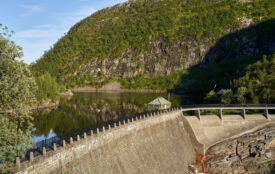All polar bears across the Arctic face shorter sea ice season
Polar bears are among the animals most affected by changes in Arctic sea ice because they rely on this surface for essential activities such as hunting, traveling and breeding.
A new study by University of Washington researchers, funded by NASA, finds a trend toward earlier sea ice melt in the spring and later ice growth in the autumn across all 19 polar bear populations, which can negatively impact the feeding and breeding capabilities of the bears. The paper, to appear September 14 in The Cryosphere, a journal of the European Geosciences Union, is the first to quantify the sea ice changes in each polar bear subpopulation across the entire Arctic region using metrics that are specifically relevant to polar bear biology.
“This study shows declining sea ice for all subpopulations of polar bears,” said co-author Harry Stern, a researcher with the University of Washington’s Polar Science Center. “We have used the same metric across all of the polar bear subpopulations in the Arctic so we can compare and contrast, for example, the Hudson Bay region with the Baffin Bay region using the same metric.”
The analysis shows that the critical timing of the sea ice break-up and sea ice freeze-up is changing across all areas in a direction that is harmful for polar bears.
Nineteen separate polar bear populations live throughout the Arctic, spending their winters and springs roaming on sea ice and hunting. The bears have evolved mainly to eat seals, which provide necessary fats and nutrients in the harsh Arctic environment. Polar bears can’t outswim their prey, so instead they perch on the ice as a platform and ambush seals at breathing holes or break through the ice to access their dens.
“Sea ice really is their platform for life,” said co-author Kristin Laidre, also a researcher at the Polar Science Center. “They are capable of existing on land for part of the year, but the sea ice is where they obtain their main prey.”
The new study published in The Cryosphere draws upon 35 years of satellite data showing daily sea-ice concentration in the Arctic. Across all 19 polar bear populations, the researchers found that the total number of ice-covered days declined at the rate of 7 to 19 days per decade between 1979 and 2014. Sea ice concentration during the summer months—an important measure because summertime is when some subpopulations are forced to fast on land—also declined in all regions, by 1 percent to 9 percent per decade.
The most striking result, researchers said, is the consistent trend across all polar bear regions for an earlier spring ice melt and a later autumn freeze-up. Arctic sea ice retreats in the springtime as daylight reappears and temperatures warm. In the autumn months the ice sheets build again as temperatures drop.
“These spring and fall transitions bound the period when there is good ice habitat available for bears to feed,” Laidre said. “Those periods are also tied to the breeding season when bears find mates, and when females come out of their maternity dens with very small cubs and haven’t eaten for months.”
The researchers found that on average, spring melting was three to nine days earlier per decade, and autumn freeze-up was three to nine days later per decade. That corresponds to a roughly 3 ½ week shift at either end—and seven weeks of total loss of good sea ice habitat for polar bears—over the 35 years of Arctic sea ice data.
“We expect that if the trends continue, compared with today, polar bears will experience another six to seven weeks of ice-free periods by mid-century,” Stern said. The trend appears to be linear and isn’t accelerating or leveling off, he added.
The study’s results currently are used by the International Union for Conservation of Nature polar bear specialist group, which completes assessments of polar bears and issues the species’ conservation status. The researchers plan to update their findings each year as new ice coverage data are available.
“It’s nice to see this work being used in high-level conservation goals,” Laidre said.
The study was funded by NASA and the Greenland Institute of Natural Resources.
###
Please mention the name of the publication (The Cryosphere) if reporting on this story and, if reporting online, include a link to the paper (http://www.the-cryosphere.net/10/2027/2016/) or to the journal website (http://www.the-cryosphere.net). This research is presented in the paper ‘Sea-ice indicators of polar bear habitat’ to appear in the EGU open access journal The Cryosphere on 14 September 2016.
The scientific article is available online, free of charge, from the publication date onwards, at http://www.the-cryosphere.net/10/2027/2016/. The PDF of the final paper is available for download below. Citation: Stern, H. L. and Laidre, K. L.: Sea-ice indicators of polar bear habitat, The Cryosphere, doi:10.5194/tc-10-2027-2016, 2016
Links
- Scientific paper: http://www.the-cryosphere.net/10/2027/2016/ (link will be active after the embargo lifts)
- Journal – The Cryosphere: http://www.the-cryosphere.net
- Images available to download: https://flic.kr/s/aHskGqx4Af








